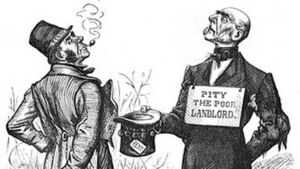Athy's battle with the town landlord

A 19th century caricature of an Irish landlord reduced to begging for rent
THE passing of the Land Act in 1870 was the first success of the Irish tenant farmers in their long struggle against Irish landlordism.
This Gladstonian enactment gave the tenant farmers the right to be compensated in the event of eviction and for improvements carried out during their tenancy.
However, it did not secure for these hard pressed people the security of tenure which they had so long sought. Moreover the much heralded Land Act enabled Landlords to contract out of its provisions, thereby leaving their tenants without even the limited benefits of Gladstone’s measure.
The Athy and Co Kildare landlord, the Duke of Leinster, was amongst the first of the Irish landlords to attempt to defeat his tenants’ rights under the 1870 Act.
The Leinster Lease, as it became known, a model of legal ingenuity, was presented by the Duke’s agents to his various tenants. Prepared with the Duke’s interest in mind, it totally and cruelly side-stepped the 1870 Act which the tenant farmers had so recently welcomed.
Local opposition to the terms of the Leinster Lease saw the foundation of the Tenants’ Defence Association in Athy.
This was the first such association formed in Ireland after the original Tenants’ Defence Association declined following the passing of the 1870 Land Act of Isaac Butt’s Tenant League of 1868.
The Athy Tenants’ Association held its first meeting on Tuesday 19 November 1872 with Captain Morgan of Rahinderry in the chair.
Local man Thomas P. Kynsey J.P. acted as Secretary to the meeting.
In the years immediately following the foundation of the Tenants’ Defence Association in Athy, the Duke of Leinster succeeded in overcoming local opposition to the terms of the Leinster Lease.
Some of the association’s leaders were themselves to accept the terms of the lease, undoubtedly under the threat of eviction.
One such signatory was James Leahy, chairman of Athy Town Commissioners, who admitted signing the Leinster Lease for his farm at Ardscull. In 1878 the duke submitted the Lease to Athy Board of Guardians in respect of some land held by them as tenants of the Leinster estate.
At a special board meeting on 1 January 1879, the guardians declined to execute the lease indicating “that this board, as the representatives of the people decline to give their signatories to a document directly opposed to the provisions of the Land Act of 1870”.
Opposition to the Leinster Lease was maintained at a low key throughout 1879 and 1880 but evictions in September 1880 of tenants of the Verschoyle Estate prompted the formation of a local branch of the Land League. Public agitation in Athy took on a new and more fervent pitch under the guidance of local land league organiser Michael Boyton.
On Sunday, 10 October 1880, the first Land League meeting was held in Athy. Addressed by Michael Boyton, the assembled crowd was told that he had come to Athy “commissioned by Charles Stewart Parnell to establish the Athy branch of the Land League”.
The Athy Land League had Dr Patrick O’Neill as vice president, Timothy Byrne as treasurer and John Cantwell as secretary.
On 8 January 1881, reported a Land League meeting in the Market Square, Athy during which Michael Boyton burnt a copy of the Leinster Lease.
However, within a few weeks local public support for the Land League was seriously undermined by a clerical instigated tenants’ agreement to accept a 20 per cent rent reduction offered by the Duke of Leinster.
The Land League was not mentioned at the meeting chaired by Rev Dr Kavanagh which accepted the new rents and Dr Patrick O’Neill, the League’s Vice President, resigned because “the acceptance of the Duke’s offer had broken the backbone of the local Land League”.
During the period of the Tenants’ Defence Association and the Land League one finds no evidence in the minutes of Athy Town Commissioners of support for the tenant farmers.
The commissioners silence probably owed much to the servile attitude adopted by successive commissioners over many years to the town’s landlord – the Duke of Leinster.
The first indication of their deviation from the subservience of their predecessors was the passing of a resolution on 6 June 1881, requesting the extension of the provisions of the Land Bill to leaseholders as well as yearly tenants.
This innocuous enough request was to be followed on 2 January 1882 by support for Charles Stewart Parnell in a resolution which called on the Government to release Parnell “and the other prisoners confined under the Coercion Act”.
Further evidence of the more independent and nationalistic line adopted by Athy Town Commissioners was given on Sunday 5 Jul 1885 with the presentation to Michael Davitt of an address by the Commissioners Chairman, Michael Doyle, on the occasion of Davitt’s visit to Athy.
While Land League activity throughout the country went on a pace throughout the 1880’s, Athy, which in 1872 had given Ireland the first of the new wave Tenants’ Defence Associations, was little concerned with the nation’s struggle.
All was to change with the advent of land problems in the little village of Luggacurran in 1886.





